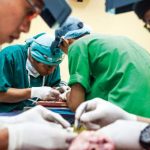Building a medical system without a foundation?

Among Cambodia’s 11 registered medical schools, many lack basic resources for hands-on training – including cadavers. As a result, instructors, doctors and students worry about the future of the profession in a country already distrustful of its health care system. In 2014, the University of Health Sciences – Cambodia’s leading public medical institution – was forced to stop using human cadavers for its medical training and substitute the corpses with live pigs. The Kingdom has no law on the donation of corpses to science, and police feared the cadavers might have been murder victims. The university only had four cadavers at the time, and they had begun to decay, says Dr Nhem Aklinn, the head of the UHS simulation lab. The formaldehyde they were using to preserve them was toxic, causing health problems among students and professors. The odor wasn’t helping, either. So now, just once or twice a year, the Kingdom’s advanced medical students administer anaesthesia, perform surgery and try to control the bleeding on the pigs. If they wake up, the medical students have “done well” – although their long-term prognosis is unknown, Aklinn says. But for now, the pigs will have to do the trick.

